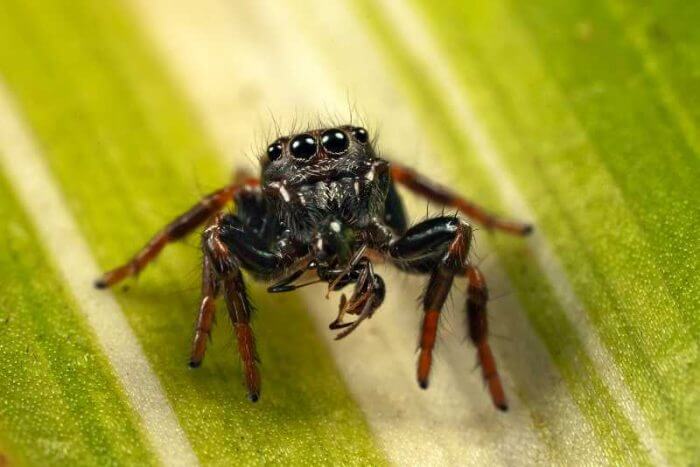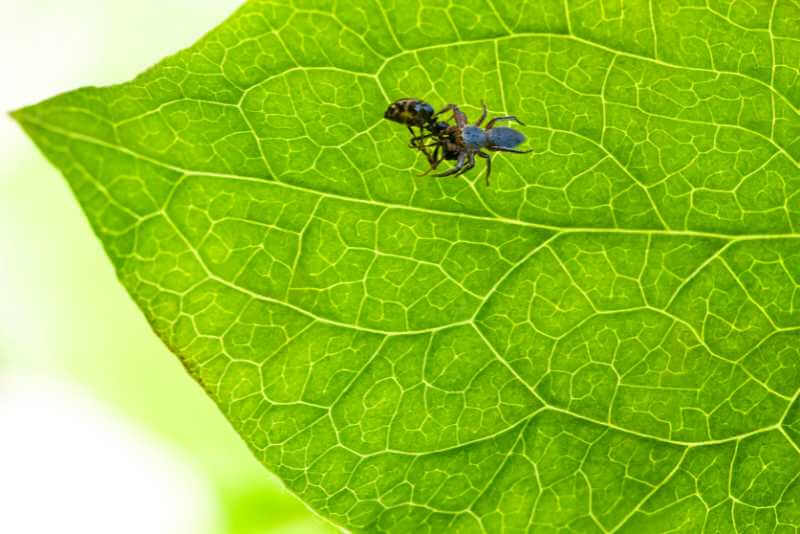In the wild, a jumping spiders diet can vary depending on the species and their habitat. While some like feeding on insects and other arthropods, others opt in for more interesting prey! Which bring us to the question do jumping spiders eat ants?
The answer is yes, some species of jumping spiders do eat ants, however, this is not their primary choice! While some species have been observed to prey on ants, it’s typically more of a survival strategy rather than a preferred hunting choice.
There’s also significant risks involved when a jumping spider chooses to hunt and eat ants! For example, when the spider attempts to prey on an ant, there is the potential for injury. Ants can also produce formic acid in their bites, which can harm the spider. Weaver ants, for instance, are particularly good at fending off most spiders that wonder onto their territory.
Also, ants often live in large colonies, which means, if a spider tries to eat one, it could quickly find itself outnumbered and under attack. As Ximena Nelson, a leading expert on myrmecomorphy (resembling an ant), states, “Most spiders are afraid of ants” due to their aggressive nature.
Types Of Jumping Spiders That Eat Ants
While it’s not common, some species of jumping spiders do indeed eat ants. However, these tend to be smaller species that live in environments where ants are a readily available food source.
These jumping spiders can include:
- Anasaitis canosa
- Siler collingwoodi
- Zodarion Spiders
- Salticus scenicus

These jumping spiders that can be found in a variety of environments. They are most commonly found in partially shaded, moist environments, often inhabiting woodlands, or plants, and other areas where ants are also present.
Does The Myrmarachne Formicaria Spider Eat Ants?
Surprisingly, there is one species of jumping spider called the Myrmarachne formicaria spider, which is able to mimic ant movements to trick predators and get closer to their prey without being noticed. However, they don’t harm or consume ants, instead they eat small flies and mosquitos.
How Do Jumping Spiders Catch And Eat Ants?
Jumping spiders capture their prey, by employing a unique hunting strategy that involves sneaking up on their prey “in this case ants” and then pouncing on them. Once they’ve caught their prey, spiders use their pedipalps to hold it in place while they bite it with their fangs.
The fangs inject a digestive enzyme into the insect that liquefies its insides. Then the spider can drink its meal, like a powerful protein shake.
How Often Do Jumping Spiders Eat Ants?
Jumping spiders are known for their agility and ability to prey on other insects. While they do occasionally eat ants, there is not much evidence to suggest how often they actually do so.
In fact, their diet can vary greatly depending on the species and location. While they may occasionally feast on ants, they also hunt and eat other insects such as flies, moths, and beetles.
Are Ants Healthy For Jumping Spiders?
Ants can provide jumping spiders with essential nutrients such as protein and fat, which are crucial for their survival. However, it’s important to note that not all ants are created equal when it comes to nutrition.
Some species of ants have higher nutritional value than others. Additionally, too much of a good thing can also be harmful.
For example, if your thinking about feeding your jumping spider ants, this could lead to a lack of diversity in their diet, which could ultimately impact the jumping spider’s overall health.

How Many Ants Do Jumping Spiders Eat?
So, how many ants can a jumping spider consume at once? Usually one at a time. Due to their small size, jumping spiders focus on taking down individual prey items rather than attacking a group of insects at once.
In fact, if a spider were to attack a large group of ants, the tables could quickly turn and the spider could find itself becoming a meal for the ants.
Can Jumping Spiders Live Solely On Ants?
Although jumping spider can eat ants, there is a debate surrounding whether or not they can live solely on ants. While it’s true that some species of jumping spiders have been observed hunting and consuming ants, studies have shown that their diets are more diverse than just one type of prey.
In the wild, these spiders have also been observed consuming other insects, such as beetles and caterpillars, in order to obtain the necessary nutrients for survival. So while ants can certainly be a part of a jumping spider’s diet, it is unlikely that they can live solely on them.
Can You Feed Ants to Your Pet Jumping Spider?
Jumping spiders are known to have a diverse diet, and they do indeed eat ants. However, it is important to consider the type of ants and the risks associated with feeding them to your pet spider.
Some ants may not be suitable prey for jumping spiders due to their size or defensive mechanisms. Larger ants or those with strong defenses, such as stings or formic acid bites, can pose a risk to your pet spider.
As a responsible pet owner, it’ always best to research the particular ant species before offering it to your jumping spider.
When it comes to feeding your pet jumping spider, variety is key to ensuring a healthy and balanced diet. Other popular food options include:
- Crickets: These insects are highly nutritious and a common choice for feeding pet spiders.
- Fruit flies: A suitable option for smaller jumping spiders that require tiny prey.
- Small moths: Another viable food choice that can be easily found in nature.
While jumping spiders are primarily carnivorous, some species have been known to drink nectar, and there is even one species that primarily consumes plant material.
However, it’s essential to prioritize protein-rich food sources when feeding your jumping spider to support its growth and overall health.
Conclusion
So there you have it, jumping spiders do eat ants however, its not that often! Ifg the jumping was to cross paths with a single ant then it would most likley eat it. But, a small group of ants forget it, its just risky.
If you found this article helpful don’t forget we have plenty of more like this one. Feel free to exploy our site and see what else you can learn.



